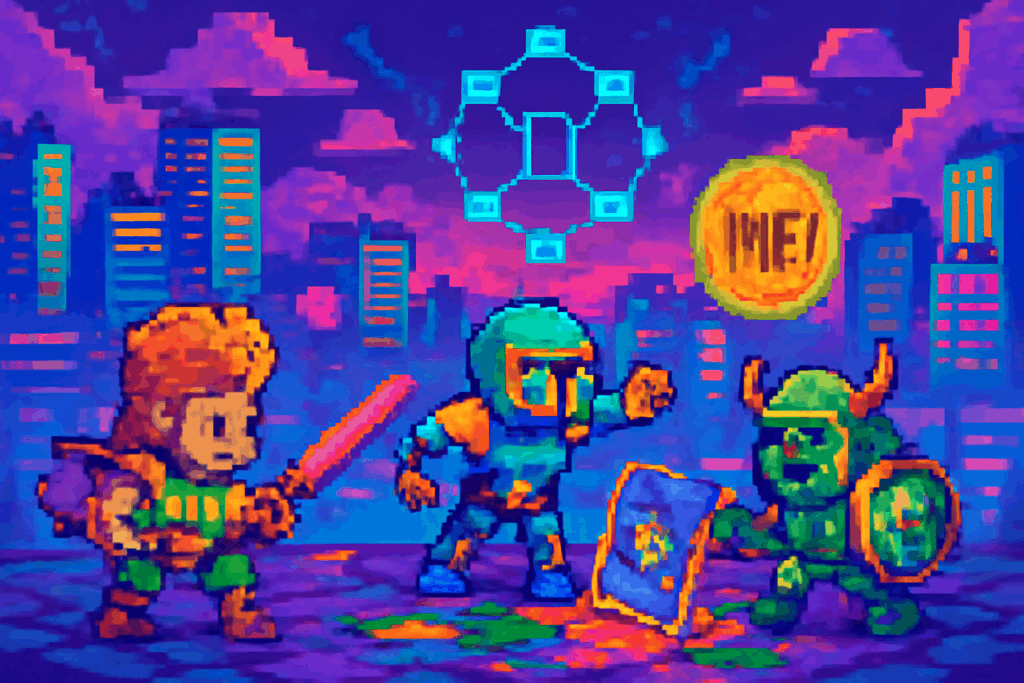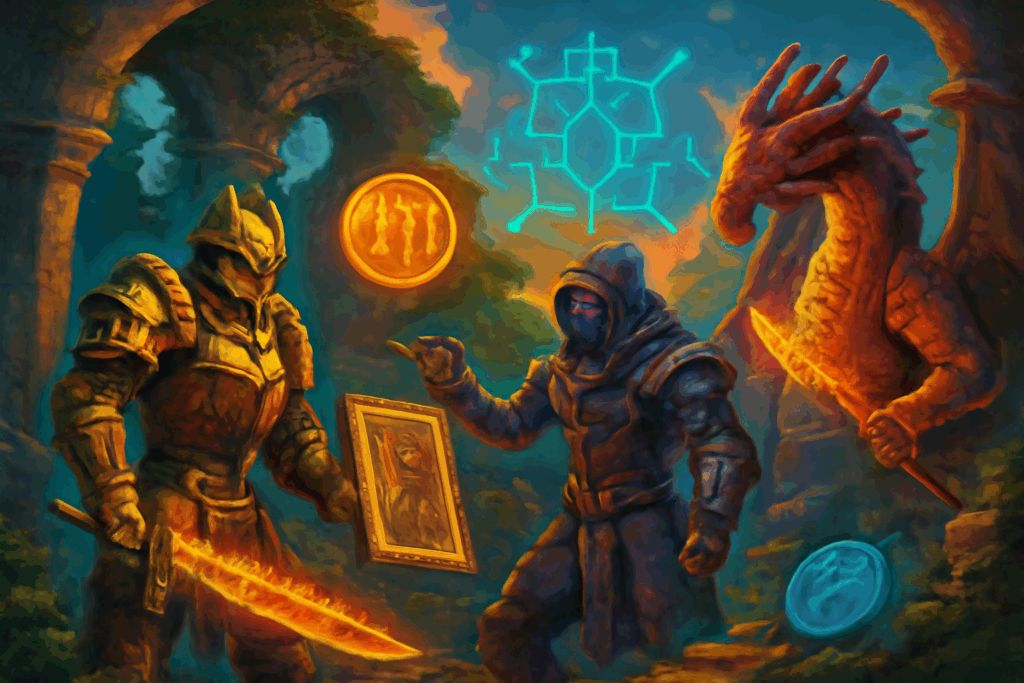Introduction
Over the past few years, the gaming industry has undergone a transformation unlike anything seen before. What was once purely about entertainment has now evolved into a new digital economy, thanks to NFTs (non-fungible tokens) and blockchain technology. Together, they’ve introduced the concept of Play-to-Earn (P2E) gaming—where players don’t just play for fun but also gain real-world financial value from their time and effort.
The idea that your sword, avatar skin, or in-game plot of land can be owned, traded, and sold for actual profit has ignited a global movement. NFT gaming has already produced million-dollar projects, built massive online communities, and created financial opportunities in developing countries. But as fast as it has grown, the space is also evolving at lightning speed, raising questions about sustainability, risks, and the future of digital economies.
In this article, we’ll explore the evolution of Play-to-Earn gaming, what makes it so unique, the challenges it faces, and where the industry is heading in 2025 and beyond.
See more: 2019 Isobel Cup Playoffs Preview
What Is Play-to-Earn?
Traditional games—from World of Warcraft to Fortnite—have long included virtual economies. Players grind for rare items, skins, or gold, but the ownership of those assets ultimately belongs to the game publisher. No matter how many hours you spend leveling up your character, you can’t legally cash out that value.
Play-to-Earn flips this model on its head.
In P2E games, the assets you earn—whether a digital pet, a piece of armor, or a plot of land—are NFTs stored on a blockchain. That means they are truly yours, and you can sell them in open markets, trade them with other players, or even use them across different games in the future.
For example:
- In Axie Infinity, players breed and battle digital creatures (Axies) that can be sold for cryptocurrency.
- In Decentraland, land parcels are NFTs that can be developed, rented, or flipped for profit.
- In Illuvium, powerful monsters and resources have real-world value because of their scarcity and demand.
This model doesn’t just reward skill or dedication—it creates digital livelihoods. In places like the Philippines, Venezuela, and parts of Africa, P2E has even become a side income or, in some cases, a full-time job.
How NFTs Add Value to Gaming
At the heart of P2E games are NFTs—unique digital tokens that prove ownership of in-game assets. Unlike traditional digital files, which can be copied endlessly, NFTs are verifiable and scarce, which gives them economic value.
Here’s how NFTs transform gaming:
- True Ownership – When you buy an NFT-based weapon or skin, it’s stored in your crypto wallet, not on the game’s server. Even if the game shuts down, you still own the asset.
- Interoperability – Some projects are exploring ways to make NFTs usable across multiple games or metaverses. Imagine taking your sword from one fantasy RPG into another.
- Tradable Value – Because NFTs exist on public blockchains, they can be sold on marketplaces like OpenSea, Blur, or Magic Eden. This liquidity gives them real-world value.
- Scarcity and Rarity – Developers can limit the number of certain NFTs, creating demand similar to collectibles in the physical world. Just as rare Pokémon cards or limited-edition sneakers can skyrocket in value, so too can rare NFT game items.
This concept of ownership and trading is why NFT gaming feels revolutionary—it transforms time spent gaming into time spent investing.
The Rise of Play-to-Earn Communities
One of the most fascinating aspects of NFT gaming is not just the profits—it’s the communities that have formed around them.
In traditional gaming, guilds and clans exist primarily for teamwork and competition. In NFT gaming, these groups often function like mini digital economies. For example:
- Scholarship Programs – In Axie Infinity, many investors bought NFTs and loaned them to “scholars” (players who couldn’t afford the upfront cost). The profits were then split, creating a new type of employer-employee relationship in the gaming world.
- Guilds and DAOs – Organizations like Yield Guild Games (YGG) are building decentralized gaming guilds that invest in NFT assets, then rent them to players while fostering community-driven governance.
- Global Participation – P2E communities have created financial bridges across continents. A player in Southeast Asia can team up with an investor in the U.S. and a strategist in Europe, all profiting from the same game.
These communities are not just about making money—they’re about belonging to a movement. They provide training, mentorship, and even financial literacy education for players who are new to crypto.

Challenges and Concerns
Of course, no revolution comes without growing pains. While NFT gaming offers unprecedented opportunities, it also faces significant challenges:
- Market Volatility – The value of NFTs and in-game tokens can swing wildly, often tied to crypto markets. A sword worth $500 today could be $50 tomorrow.
- High Entry Costs – Popular games like Axie Infinity initially required buying multiple NFTs just to start playing, sometimes costing hundreds of dollars. This created a barrier for newcomers.
- Scams and Rug Pulls – The rapid growth of NFT gaming has attracted bad actors. Some projects launch with big promises, raise millions, then disappear.
- Sustainability of Rewards – Some games rely heavily on new players joining to maintain token prices, raising concerns about Ponzi-like structures.
- Environmental Impact – While many blockchains are moving toward eco-friendly consensus mechanisms, early NFT projects raised alarms about energy use and carbon footprints.
- Regulation Uncertainty – Governments worldwide are still figuring out how to regulate NFT gaming, especially since it blurs the line between gaming, investing, and gambling.
These challenges underscore the importance of responsible participation—treating P2E not as a guaranteed income but as a high-risk, high-reward frontier.
The Future of NFT Gaming
So, where is Play-to-Earn headed next? While the initial hype wave may have cooled, the foundation is solid—and innovation is accelerating. Here’s what the future may hold:
- Shift Toward Play-and-Earn – Instead of games designed only for profits, developers are now emphasizing fun-first gameplay. Rewards will remain, but the focus is moving back to creating engaging experiences that stand on their own.
- Mainstream Studios Entering – Traditional giants like Ubisoft, Square Enix, and EA are already experimenting with blockchain integration. As big studios refine the model, NFT gaming could hit the mainstream.
- Cross-Game Economies – Expect to see progress in interoperability, where assets from one game could be usable in another. This will further blur the lines between individual games and shared metaverse economies.
- Integration with Metaverse Platforms – NFT games will increasingly tie into broader metaverse worlds like The Sandbox, where gaming, social interaction, and digital commerce converge.
- Regulation and Protection – With clearer regulations, scams may decrease, and more institutional investors may feel safe entering the space.
- Mobile P2E Gaming – As mobile penetration grows, especially in developing regions, P2E will continue to spread globally. Imagine casual games like Candy Crush but with NFTs and tokenized rewards.
The evolution of P2E will likely transform gaming from a hobby into a hybrid of entertainment, investment, and digital identity.
Conclusion
NFT gaming and the Play-to-Earn model have already reshaped the way we think about games. What started as a niche experiment has turned into a global digital economy, enabling players to turn passion into profit and build thriving communities across borders.
Yes, there are challenges—market risks, scams, and sustainability concerns—but the long-term potential is enormous. By blending entertainment with real-world value, P2E games are opening doors to new financial opportunities, social connections, and innovations in digital ownership.
As we look ahead, the key will be balance: games must remain fun, sustainable, and transparent, while still rewarding players for their time and skill. The evolution of Play-to-Earn is just beginning, and whether you’re a gamer, investor, or curious observer, one thing is clear: NFT gaming isn’t just a trend—it’s the future of interactive entertainment.

